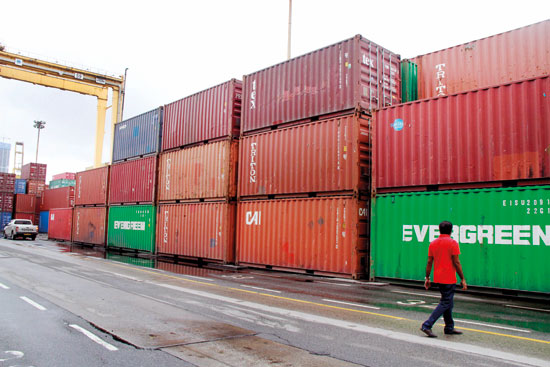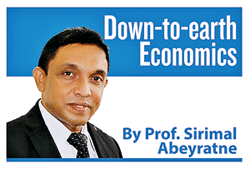Stolen American jobs
View(s):What little supply existed was mostly reserved for healthcare workers, many of whom had to reuse their masks. At the same time, the public was urged to wear masks to help stop the spread of the virus. Demand surged, but supply couldn’t keep up.

File picture of the Colombo Port. Will Sri Lanka import LNG from the US to balance the trade deficit?
Prepared for COVID?
Critiques questioned how the wealthiest nation in the world, with access to a quarter of global income, couldn’t produce something as simple as a face mask. Others blamed the authorities for being “unprepared”—but, really, who was?
Before the pandemic, the US relied heavily on mask imports from China, which produced around half of the world’s supply. But once the pandemic hit, those exports dropped sharply. China, the epicentre of the outbreak, went into lockdown ahead of most countries. Factories shut down, and domestic mask demand spiked, leaving little room for exports.
Now critiques may question that China was a country which was able to produce enough masks not only for its own people but also for export. Some could even suggest that China was better prepared for the emergency.
So why was the US unable to do what China managed? The answer may lie in the theory of “comparative advantage,” which is often misunderstood or misused.
Growing and shrinking industries
 Comparative advantage doesn’t refer to simple cost differences between countries. It’s about opportunity cost—the value of what must be given up to produce one thing instead of another. In an “open economy”, some industries could wither away not because their products are more expensive than imports, but because their resources—especially labour—could be used more efficiently elsewhere.
Comparative advantage doesn’t refer to simple cost differences between countries. It’s about opportunity cost—the value of what must be given up to produce one thing instead of another. In an “open economy”, some industries could wither away not because their products are more expensive than imports, but because their resources—especially labour—could be used more efficiently elsewhere.
When industries shrink under import pressure, their resources (like labour and capital) tend to shift toward sectors that are growing and expanding. This process, known as specialisation, is natural in open economies. Inefficient industries fade, while efficient ones thrive.
As nations develop, they often phase out less productive sectors—unless those sectors evolve and become more competitive. In turn, industries that can succeed in a competitive global market grow and expand. While some jobs and industries may be lost in the short term, the overall economic benefit in the long run is greater.
This transformation helps countries become wealthier and more prosperous. On the other hand, countries that cling to inefficient industries—shielding them from competition—tend to lag behind, stifling the growth of sectors with true potential.
From simplicity to complexity
This path of specialisation and reallocation helped the US rise to become the world’s richest country—just as it did for other advanced economies and emerging ones like China and India. Over time, the US moved away from basic manufacturing, like face mask production, in favour of more high-tech, knowledge-driven industries.
Protecting simple manufacturing would have meant sacrificing free trade—a strategy that contributed immensely to US prosperity. So, the question arises: Would preserving basic industries at the cost of free trade have been worth it for a nation focused on growth and prosperity
Still, there’s a darker side of free trade. As inefficient industries collapse, less-educated and less-skilled workers often lose jobs and incomes. In the US, over the past few decades, this has led to deepening social challenges in low-income communities. Instead of retraining, reskilling and transitioning these workers into new sectors, many have been left behind.
Meanwhile, specialisation has fuelled growth in high-tech and advanced industries, creating demand for well-educated, highly skilled professionals—offering better jobs and higher incomes. This contrast has shaped the wealth and prosperity seen in developed nations.
Two sides of the same coin
Shrinking industries didn’t simply vanish. They relocated—mostly to countries like China, India, and across Asia—where they found more favourable business conditions.
As developing nations began opening their economies, they created environments that welcomed capital outflows from advanced countries like the US. These Asian economies started attracting investment, fuelling their own development.
Over the past few decades, global capital flows—especially in the form of foreign direct investment (FDI)—have grown four to five times. A significant share of this came from advanced economies and moved into China and other Asian countries.
Production itself became more globally fragmented. Manufacturing processes were split vertically—advanced stages like research and development (R&D) stayed in richer nations, while labour-intensive tasks were outsourced to multiple developing economies. This gave rise to sprawling global value chains.
This shift led to job and income losses in advanced economies, but it created new employment opportunities and income growth in emerging markets. These outsourced industries were typically labour-intensive and helped promote inclusive growth in regions where labour had previously been underutilised.
Recovery of stolen jobs
Two weeks ago, GE Appliances made a stunning announcement – it is coming back from China to the US. Originally, GE Appliances was part of the General Electric Company (GE) of the US. It is a massive American industrial conglomerate with a global footprint in 170 countries.
GE was founded 133 years ago by a few industrialists and inventors, including Thomas Alva Edison whose name is associated with the development of the light bulb. During the first half of the 20th century, GE grew into a global industrial powerhouse. Today, GE runs 82 manufacturing plants in the US and Puerto Rico and, another 149 plants in 34 other countries.
In 2016, GE Appliances division was sold to a Chinese appliances’ company called Haier Group. Since then, GE Appliances has been a US-based subsidiary of Haier, operating independently but still using the GE brand name.
It was exciting news to the US that GE Appliances announced its decision to move back from China to Kentucky in the US. Accordingly, it will spend $490 million to produce more than 15 washer models generating at least 800 jobs.
As the CEO of GE Appliances explained, the company is adopting “zero-distance” strategy by bringing production facility closer to its designers and engineers as well as to the consumers. And more importantly, as the US anticipated with its new policies, the stolen jobs can be recovered by this strategy.
They can do that
Does Trump policies begin to bear fruit at last? What matters is that, after all US imports become expensive after applying Trump’s reciprocal tariffs so that the customers must pay a higher price whether the washing machines are imported or domestically produced.
Secondly, the US government has promised to provide numerous incentives – tax incentives, performance-based grants, training grants and modernisation grants – all funded by taxpayer money.
The larger goal was to encourage American companies operating overseas to relocate back to the US. But how viable is this strategy in practice? Can American consumers and taxpayers sustain the financial weight required to drive such momentum?
Even if the US government and the US people could do that, we should not jump into it thinking that “if the Americans can do that why not the Sri Lankans?” The Americans can kick off the ladder, because they have already climbed up. It is not a good lesson for Sri Lanka which is still on the lower rungs of the ladder.
(The writer is Emeritus Professor at the University of Colombo and Executive Director of the Centre for Poverty Analysis (CEPA) and can be reached at sirimal@econ.cmb.ac.lk and follow on Twitter @SirimalAshoka).
Hitad.lk has you covered with quality used or brand new cars for sale that are budget friendly yet reliable! Now is the time to sell your old ride for something more attractive to today's modern automotive market demands. Browse through our selection of affordable options now on Hitad.lk before deciding on what will work best for you!


